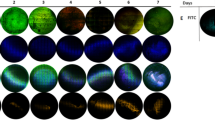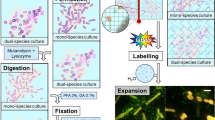Abstract
The objective of the study was to establish an in vitro model of Candida albicans–Staphylococcus epidermidis mixed species biofilm (BF) on polyvinyl chloride (PVC) material, and to investigate the formation and the structure of mixed species BF formation using a combined approach of confocal laser scanning microscope (CLSM), scanning electron microscope (SEM), and 3D image reconstruction technique. Mixed species BF is achieved by co-incubating Staphylococcus epidermidis bacteria (ATCC35984) and Candida albicans fungal (ATCC10231) with PVC pieces in Tris-buffered saline. BF formation was examined at 2, 6, 12, 24, 48, and 72 h of co-culture. Thickness of these BFs and the number, and percentage of viable cells in BFs were measured. CT scan images of BFs were obtained using CLSM and SEM and reconstructed 3D images of mixed species BF were acquired, in an effort to examine structure of the BF. Staphylococcus epidermidis attached to various forms of candida albicans (spores, pseudohyphae, and hyphae), formed complex and dense mesh arrays. The BF is constituted of a large number of viable and dead pathogens, the surface of mixed species BF is uneven, with living pathogens predominating protrusive portions and dead pathogens aggregating in concaves. Mixed species BF formation on the surface of PVC material was found to be a dynamic process, with rapid growth being at 24 h of co-culture, maximal thickness peaked at 48 h. These mixed species BF matured at 48–72 h. Significant differences were observed in the proportion of viable cells between interior, middle, and outer layers of BFs (p < 0.05). Mixed species BF Candida albicans–Staphylococcus epidermidis is sophisticated in structure. The combined approach involving CLSM, SEM, and 3D image reconstruction technique is ideal for the investigation of mixed species BF on PVC material.






Similar content being viewed by others
REFERENCES
Stoodley, P., Sidhu, S., Nistico, L., et al. (2012). Kinetics and morphology of polymicrobial biofilm formation on polypropylene mesh. FEMS Immunology and Medical Microbiology, 65(2), 283–290.
Li, D., Zhang, W., Zheng, S., et al. (2013). Surveillance study of candidemia in cancer patients in North China. Medical Mycology, 51(4), 378–384.
Grim, S. A., Berger, K., Teng, C., et al. (2012). Timing of susceptibility-based antifungal drug administration in patients with Candida bloodstream infection: Correlation with outcomes. Journal of Antimicrobial Chemotherapy, 67, 707–714.
Klotz, S. A., et al. (2007). Polymicrobial bloodstream infections involving Candida species: Analysis of patients and review of the literature. Diagnostic Microbiology and Infectious Disease, 59(4), 401–406.
Lin, Y. J., Alsad, L., Vogel, F., et al. (2013). Interactions between Candida albicans and Staphylococcus aureus within mixed species biofilms. Bios, 84(1), 30–39.
Harriott, M. M., & Noverr, M. C. (2011). Importance of Candida–bacterial polymicrobial biofilms in disease. Trends in Microbiology, 19(11), 557–563.
Pammi, M., Liang, R., Hicks, J., et al. (2013). Biofilm extracellular DNA enhances mixed species biofilms of Staphylococcus epidermidis and Candida albicans. BMC Microbiology, 13(1), 257.
Valle, J., Solano, C., García, B., et al. (2013). Biofilm switch and immune response determinants at early stages of infection. Trends in Microbiology, 21(8), 364–371.
Ye, L. H., Xu, G., Huang, Y. C., et al. (2010). Effect of bromo-furanones on Staphylococcus aureus biofilm formation in cardiothoracic surgery polyvinyl chloride surface. Biomedical Engineering and Clinical Medicine, 14(3), 203–206.
Zhao, G. Q., YeLH, Huang Y. C., et al. (2011). In Vitro model of bacterial biofilm formation on polyvinyl chloride biomaterial. Cell Biochemistry and Biophysics, 61(2), 371–376.
Dominiak, D. M., Nielsen, J. L., & Nielsen, P. H. (2011). Extracellular DNA is abundant and important for microcolony strength in mixed microbial biofilms. Environmental Microbiology, 13(3), 710–721.
Morschhäuser, J. (2010). Regulation of white-opaque switching in Candida albicans. Medical Microbiology and Immunology, 199(3), 165–172.
Chen, Xi, & Zhang, Hongxun. (2011). Approach for research into biofilm and potential control techniques. Science and Technology Review, 29(11–04), 74–79.
Almeida, C., Azevedo, N. F., Santos, S., et al. (2011). Discriminating multi-species populations in biofilms with peptide nucleic acid fluorescence in situ hybridization (PNA-FISH). PLoS ONE, 6(3), e14786.
Karcz, J., Bernas, T., Nowak, A., et al. (2012). Application of lyophilization to prepare the nitrifying bacterial biofilm for imaging with scanning electron microscopy. Scanning, 34(1), 26–36.
Alhede, M., Qvortrup, K., Liebrechts, R., et al. (2012). Combination of microscopic techniques reveals a comprehensive visual impression of biofilm structure and composition. FEMS Immunology and Medical Microbiology, 65(2), 335–342.
Xiao, J., Klein, M. I., Falsetta, M. L., et al. (2012). The exopolysaccharide matrix modulates the interaction between 3D architecture and virulence of a mixed-species oral biofilm. PLoS Pathogens, 8(4), e100262.
Acknowledgments
This study was partly supported by the Grants from the National Natural Science Foundation of China (Nos. 81260228, 81460441); and the basic research project in Yunnan Province (No. 2013FB165).
Author information
Authors and Affiliations
Corresponding author
Rights and permissions
About this article
Cite this article
Chen, Y., Wang, Xy., Huang, Yc. et al. Study on the Structure of Candida Albicans–Staphylococcus Epidermidis Mixed Species Biofilm on Polyvinyl Chloride Biomaterial. Cell Biochem Biophys 73, 461–468 (2015). https://doi.org/10.1007/s12013-015-0672-y
Published:
Issue Date:
DOI: https://doi.org/10.1007/s12013-015-0672-y




